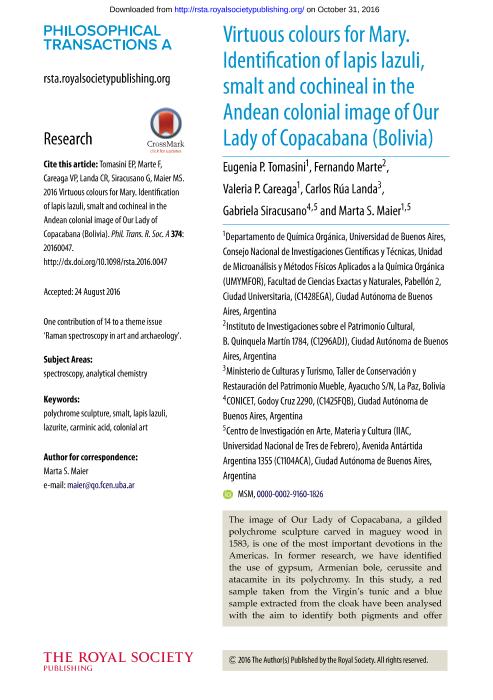Artículo
Virtuous colours for Mary. Identification of lapis lazuli, smalt and cochineal in the Andean colonial image of Our Lady of Copacabana (Bolivia)
Tomasini, Eugenia Paula ; Marte, Fernando; Careaga Quiroga, Valeria Pilar
; Marte, Fernando; Careaga Quiroga, Valeria Pilar ; Landa, Carlos Rúa; Siracusano, Gabriela Silvana
; Landa, Carlos Rúa; Siracusano, Gabriela Silvana ; Maier, Marta Silvia
; Maier, Marta Silvia
 ; Marte, Fernando; Careaga Quiroga, Valeria Pilar
; Marte, Fernando; Careaga Quiroga, Valeria Pilar ; Landa, Carlos Rúa; Siracusano, Gabriela Silvana
; Landa, Carlos Rúa; Siracusano, Gabriela Silvana ; Maier, Marta Silvia
; Maier, Marta Silvia
Fecha de publicación:
12/2016
Editorial:
The Royal Society
Revista:
Philosophical Transactions of the Royal Society A - Mathematical Physical and Engineering Sciences
ISSN:
1364-503X
e-ISSN:
1471-2962
Idioma:
Inglés
Tipo de recurso:
Artículo publicado
Clasificación temática:
Resumen
The image of Our Lady of Copacabana, a gilded polychrome sculpture carved in maguey wood in 1583, is one of the most important devotions in the Americas. In former research, we have identified the use of gypsum, Armenian bole, cerussite and atacamite in its polychromy. In this study, a red sample taken from the Virgin's tunic and a blue sample extracted from the cloak have been analysed with the aim to identify both pigments and offer insights into the painting technique. Analysis by micro-Raman spectroscopy complemented with scanning electron microscopy-energy dispersive spectroscopy and high-performance liquid chromatography allowed the identification of carmine lake in the red sample. Analysis by micro-Raman spectroscopy of the surface of the blue sample and its cross section showed the presence of smalt-The blue-glass pigment-over a cerussite layer, bathed by a very thin ultramarine layer-from a probable native origin-following a pictorial tradition that would last even until the eighteenth century. This is the first time that lapis lazuli has been scientifically identified in a Spanish American colonial painted layer. This article is part of the themed issue 'Raman spectroscopy in art and archaeology'.
Palabras clave:
Carminic Acid
,
Colonial Art
,
Lapis Lazuli
,
Lazurite
,
Polychrome Sculpture
,
Smalt
Archivos asociados
Licencia
Identificadores
Colecciones
Articulos(UMYMFOR)
Articulos de UNID.MICROANAL.Y MET.FISICOS EN QUIM.ORG.(I)
Articulos de UNID.MICROANAL.Y MET.FISICOS EN QUIM.ORG.(I)
Citación
Tomasini, Eugenia Paula; Marte, Fernando; Careaga Quiroga, Valeria Pilar; Landa, Carlos Rúa; Siracusano, Gabriela Silvana; et al.; Virtuous colours for Mary. Identification of lapis lazuli, smalt and cochineal in the Andean colonial image of Our Lady of Copacabana (Bolivia); The Royal Society; Philosophical Transactions of the Royal Society A - Mathematical Physical and Engineering Sciences; 374; 2082; 12-2016; 11
Compartir
Altmétricas



